By James W. Loewen
 This is the sesquicentennial of the Reconstruction era in the United States, that period after the Civil War when African Americans briefly enjoyed full civil and political rights. African Americans — 200,000 of them — had fought in that war, which made it hard to deny them equal rights.
This is the sesquicentennial of the Reconstruction era in the United States, that period after the Civil War when African Americans briefly enjoyed full civil and political rights. African Americans — 200,000 of them — had fought in that war, which made it hard to deny them equal rights.
Unlike with the 150th anniversary of the Civil War, however, few historic places tell us what happened during Reconstruction. They could: Every plantation home had a Reconstruction history, often fascinating, but these manors remain frozen in time around 1859. They tell a tale of elegance and power, and Reconstruction was the era when that power was challenged. Moreover, it is still true, as W. E. B. Du Bois put it in Black Reconstruction 80 years ago, that “one cannot study Reconstruction without first frankly facing the facts of universal lying.”
Here are five common fallacies that Americans still tell themselves about this formative period.
1. Reconstruction was a failure.
This view came to dominate public thinking from 1890 until about 1940, when world events and the Great Migration began to reshape the country’s perception of race and racism. During this period, known by historians as the nadir of race relations, white Americans became incredibly racist. Communities across the North became “sundown towns” that banned African Americans (and sometimes Jews and others) after dark. Beginning with Mississippi in 1890, every Southern state instituted literacy tests and poll taxes to effectively remove African Americans from the citizenship they were supposed to have been guaranteed by the 14th Amendment. Reconstruction was portrayed during this era as a terrible time, especially for whites but really for everyone, a failure of a government propped up only by federal bayonets. “No people were ever so cruelly subjected to the rule of ignorant, vicious, and criminal classes as were the Southern people in the awful days of Reconstruction,” the New Orleans Times-Picayune proclaimed in 1901.
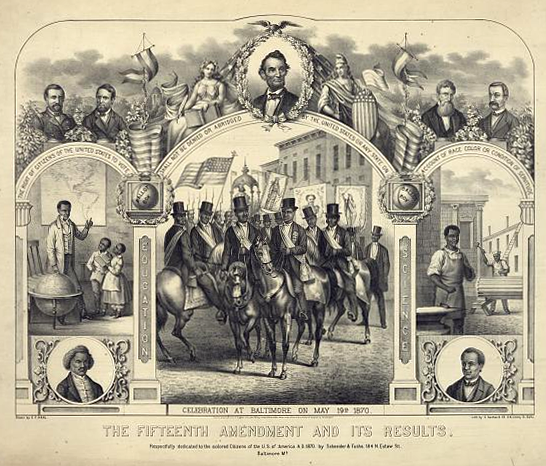
A print commemorating the Fifteenth Amendment featuring Black people’s advancement. Source: Library of Congress
Some people today even think that Reconstruction was an effort to physically rebuild the South, rather than to aid its political re-entry into the Union. In 2013, for example, the Smithsonian American Art Museum mounted a huge exhibit, “The Civil War and American Art.” “Reconstruction,” the museum claimed, “began as a well-intended effort to repair the obvious damage across the South as each state re-entered the Union.” The curator said that the rebuilding “soon faltered, beset by corrupt politicians, well-meaning but inept administrations, speculators, and very little centralized management.”
On the contrary, former Confederates saw Reconstruction as a problem precisely because it was succeeding. New Republican state administrations passed popular measures such as homestead exemption laws that abated taxes on residences, making it harder for people to lose their homes. They also repaired roads and bridges and built new schools and hospitals. Soon, Republicans were drawing 20 percent and even 40 percent of the white vote and almost all the Black vote. Democrats grew desperate. After abortive attempts to win Black votes, they resorted to intimidation and violence. These tactics were central to the restoration of white Democratic rule across the South by 1877. And thus Reconstruction ended, but not because it failed.
2. African Americans took over the South during Reconstruction.
The official Mississippi history textbook used in the 9th grade across the state in the 1960s flatly declared Reconstruction a period of “Carpetbag and Negro Rule.” This propaganda was effective: When I asked a seminar of Black freshmen at Tougaloo College near Jackson, Mississippi, in 1969 what happened during Reconstruction, 16 of the 17 students said Blacks took over the governments of the Southern states, but because they were too soon out of slavery, they messed up, and whites had to take control again. In 1979, after I moved to Vermont, I was stunned to hear the minister of the largest Unitarian Church there repeat the same summary in a sermon.
This alleged Black dominance supposedly made Reconstruction a time of terror and travail for white Southerners. The Mississippi history textbook put it baldly: “Reconstruction was a worse battle than the war ever was. Slavery was gone, but the Negro problem was not gone.” Fear of “Black domination” is still pervasive among white supremacists; note Dylann Roof’s statement to Black churchgoers in Charleston, South Carolina, as he shot them: “You are taking over our country.”

Part of the racist posters attacking Radical Republicans on the issue of Black suffrage, issued during the Pennsylvania gubernatorial election of 1866. Source: Library of Congress
But in fact, the terror and travail during Reconstruction happened mostly to African Americans and their white Republican allies. In Louisiana in the summer and fall of 1868, white Democrats killed 1,081 people, mostly African Americans and white Republicans. Around the same time in Hinds County, Miss., whites killed an average of one African American a day, especially targeting servicemen. Whites mounted similar attacks across the South.
Far from suffering under Black dominance, all of the Southern states had white governors throughout Reconstruction. All but one (South Carolina) had white legislative majorities. Mississippi’s Constitutional Convention of 1868 is still called the “Black and Tan Convention,” but only 16 of its 94 delegates were Black. Of course, a government that is 17 percent Black looks “Black” to people used to the all-white governments before and after.
3. Northerners used Reconstruction to take advantage of the South and get rich.
Many Americans still learn this canard, epitomized by the term “carpetbaggers.”
The story — as exemplified in the 2011 edition of the textbook The American Journey — is that fortune-hunters from the North “arrived with all their belongings in cheap suitcases made of carpet fabric.” Penniless, they would then make it rich off the prostrate South. John F. Kennedy said in his Pulitzer Prize-winning book Profiles in Courage, “No state suffered more from carpetbag rule than Mississippi.”
The first clue that this view might be far-fetched comes from the fact that the economies of most Southern states were in ruins. Fortune-seekers will go where the money is, and it was not in the postwar South. Instead, immigrants from the North were mostly of four types: missionaries bringing Christianity (and often literacy) to newly freed people; teachers eager to help Black children and adults learn to read, write, and cipher; Union soldiers and seamen who were stationed in Mississippi and liked the place or fell in love; and would-be political leaders, Black and white, determined to make interracial government work.
4. Republicans “waved the bloody shirt” to hide their lack of substantive policies.
“Waving the bloody shirt” has come to mean trying to win votes through demagoguery — blaming opponents for things they didn’t do or did long ago. Its first use of this sort refers to Republicans blaming Democrats for the carnage of the Civil War years after it ended. Kennedy made this claim in Profiles in Courage, writing that “Republican leaders . . . believed that only by waving the bloody shirt could they maintain their support in the North and East, particularly among the Grand Army of the Republic.” In his 2005 biography of Republican politician John A. Logan, Gary Ecelbarger accuses Logan of “waving the bloody shirt” beginning in 1866 and “for decades to come.”
Actually, the bloody shirt was a real shirt, owned by a white Republican, A.P. Huggins. He was superintendent of the Monroe County Public Schools, a majority-Black school system in Aberdeen, Miss., and took his job seriously. White supremacist Democrats warned him to leave the state, but he refused. On a March evening in 1870, they went to his home, rousted him from bed in his nightshirt and whipped him nearly to death. His bloody shirt was taken to Washington as proof of Democratic terrorism against Republicans in the South.
The violence decried happened during Reconstruction, not the Civil War, so it was not anachronistic. Nor was it demagogic to use the phrase (or wave the shirt); violence at Southern polls posed a real issue — indeed, the most important issue in the United States at the time.
5. Republicans gave up on Black rights in 1877.
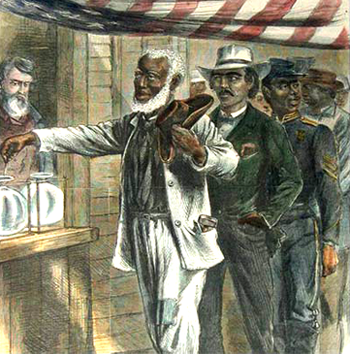
“The First Vote” from Harper’s Weekly. Source: Library of Congress
Every textbook says the Compromise of 1877 meant that “the federal government would no longer attempt to. . . help Southern African Americans,” to quote The American Journey. “Violence was averted by sacrificing the Black freedmen in the South,” according to another textbook, The American Pageant.
Republicans did eventually abandon civil rights, but not right after the Compromise of 1877 effectively ended Reconstruction. Until 1890, African Americans still voted across Dixie. In his inaugural address in 1881, Republican President James A. Garfield said: “The elevation of the Negro race from slavery to the full rights of citizenship is the most important political change we have known since the adoption of the Constitution of 1787. No thoughtful man can fail to appreciate its beneficent effect upon our institutions and people. . . . So far as my authority can lawfully extend they shall enjoy the full and equal protection of the Constitution and the laws.”
As late as 1890, Republicans in Congress almost passed the Federal Elections Act, which might have given some force to the 15th Amendment’s voting rights provisions. President Benjamin Harrison had argued for such a measure the previous year. After the act failed to pass, Democrats, as was their custom, tarred Republicans as “a bunch of n—– lovers.” In the past, Republicans replied that what white supremacists did to Black voters in the South was an outrage, but now they were silent, choosing to move on to other issues.
After the Federal Elections Act failed to pass, each succeeding Republican president was worse on civil rights. Teddy Roosevelt was worse than Harrison, Harding worse than Roosevelt, Hoover than Harding. With the nomination of Barry Goldwater in 1964, the GOP switched sides entirely, appealing now to white supremacist Southern Democrats. They have been its core constituency ever since. In 2016, Donald Trump took the presidency, installing cabinet-level officials with overt ties to white supremacists.
In other ways, too, we still have not reached the level of interracial cooperation we attained during Reconstruction. On Aug. 3, 1870, for example, A. T. Morgan, a white state senator from Yazoo City, Miss., married Carrie V. Highgate, a Black teacher from New York, in Mississippi, and then got re-elected! In the North, not a single suburb of Chicago kept out African Americans in 1870. Today Kenilworth, Ill, its richest and most prestigious, has not a single black household, in keeping with its founder’s decree back in 1902. Today, Republicans make it harder for African Americans (and students and poor people) to vote, just as Democrats did after 1890, albeit on a smaller scale.
The tragedy of Reconstruction is not that it failed, but that its successes were curtailed in 1877 and then reversed in 1890. Correcting the myths about the first Reconstruction will help us as we try to build better race relations today.
James W. Loewen is the author of Lies My Teacher Told Me, Lies Across America: What Our Historic Sites Get Wrong, The Confederate and Neo-Confederate Reader, and many other books. James W. Loewen website.
Article originally published on Jan. 21, 2016, at The Washington Post. Updated and republished here with permission of the author.
Classroom Story
I used the article Five Myths About Reconstruction and the teaching guide Freedom’s Unfinished Revolution, along with primary source narratives, to teach about Reconstruction, specifically in the state of North Carolina. We explored the general myths around Reconstruction and then placed them in the context of the primary source documents. The Zinn Education Project articles provided a solid framework to study the time and get more value out of the primary sources.
The resources found on this site are well-researched and provide excellent context for both social studies teaching as well as language arts. I currently have students in my English class reading historical fiction novels that focus on some of the underrepresented voices in American history, and I will be sending them to the Zinn Education Project to further explore topics from those novels.
Learn more in the Zinn Education Project national report, “Erasing the Black Freedom Struggle: How State Standards Fail to Teach the Truth About Reconstruction,” and find teaching resources on Reconstruction below.

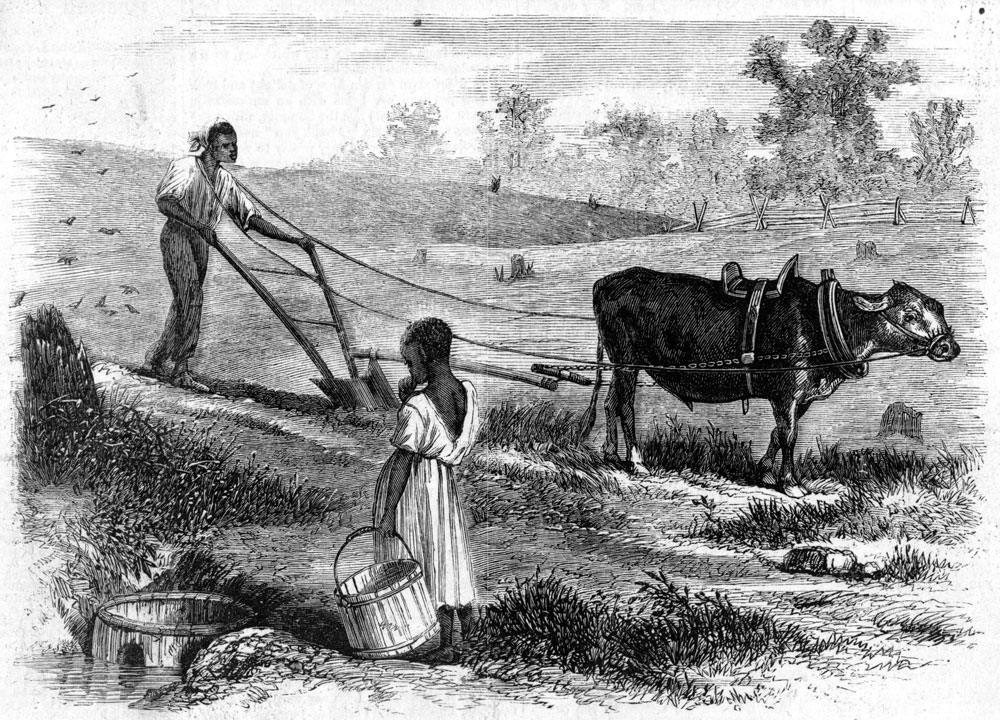
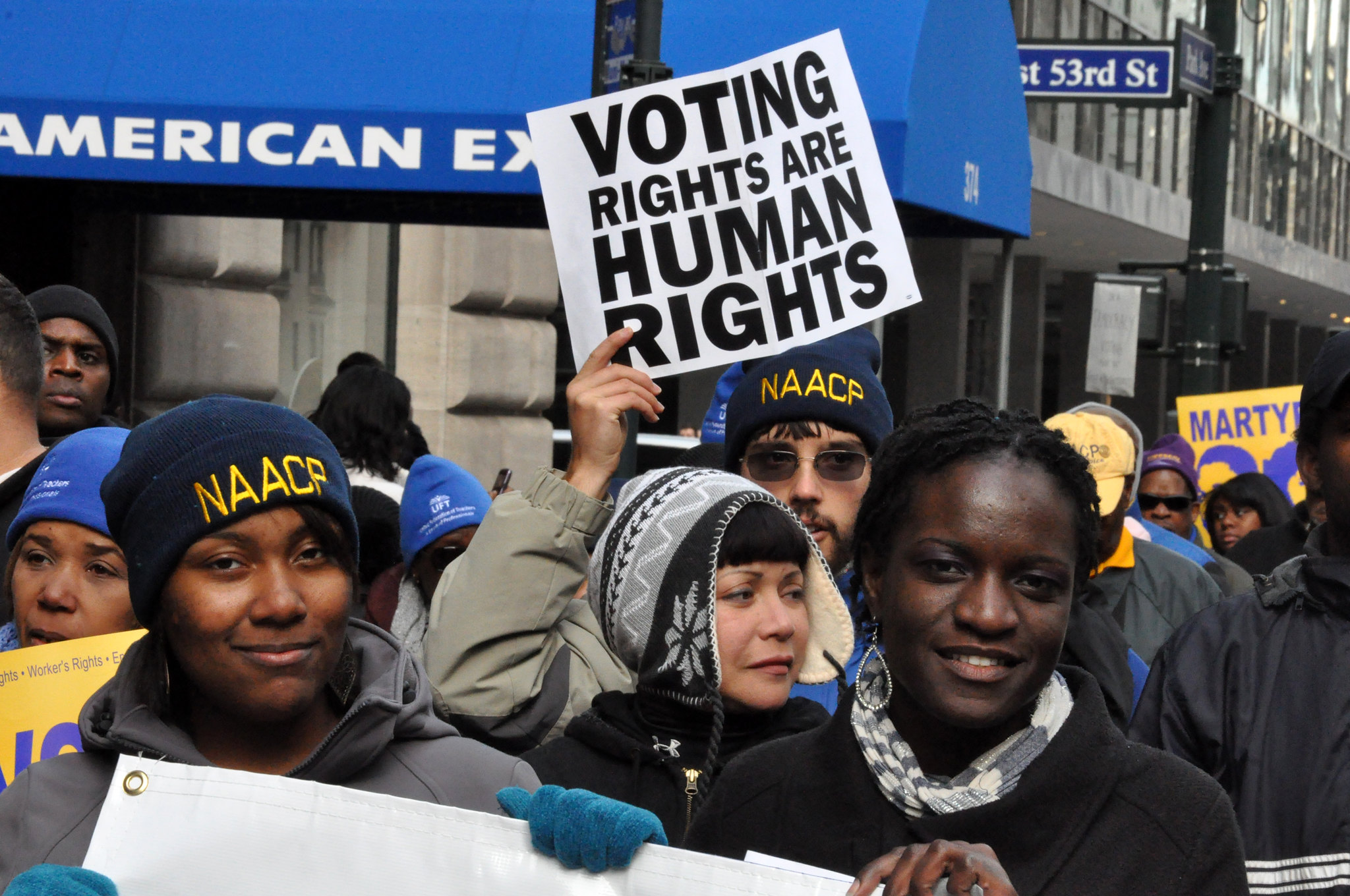
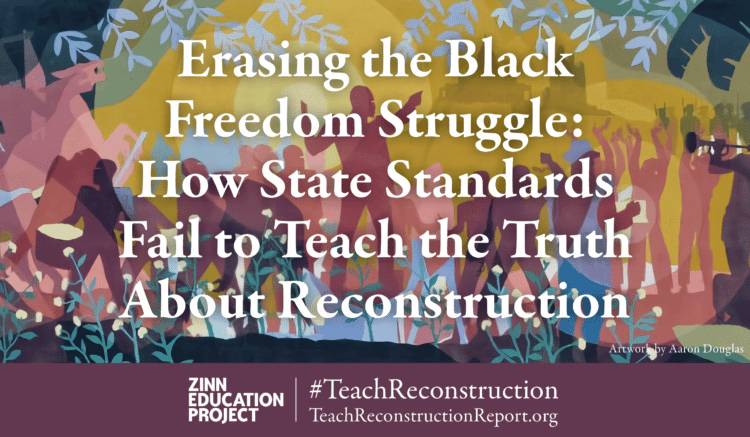

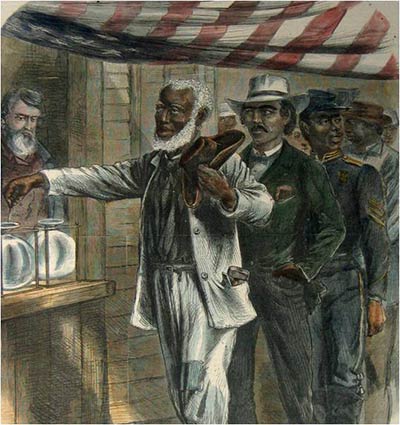
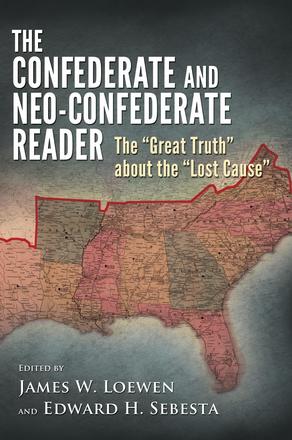






The discussion of myth #5 implies that Republicans were solely responsible for the decline in the status and fortunes of Black Americans, but this is not true. Republican Theodore Roosevelt angered Southern Democrats by inviting Booker T. Washington to dine at the White House in 1901, and consulted him regularly regarding political appointments in the South. Woodrow Wilson, a Democrat, imposed racial segregation in federal office spaces, and gave high praise to the pro-KKK movie “The Birth of a Nation.” FDR, a Democrat, resisted calls for a federal anti-lynching law, fearing the loss of Southern Democrat support for his New Deal, and segregated Whites and Blacks in the Civilian Conservation Corps camps. Neither political party can claim innocence. Both participated in Jim Crow.